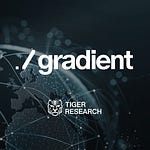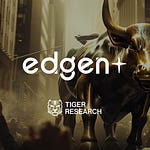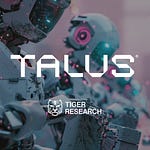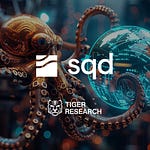This report was written by Tiger Research, analyzing Wayfinder's innovation in AI-powered DeFi infrastructure and its impact on blockchain accessibility.
TL;DR
DeFi claims to be open to everyone, but its complex usability makes it difficult for general investors to access. From preparing gas fees to understanding complex protocols, many users abandon promising investment opportunities due to the complicated procedures involved.
Wayfinder is an on-chain specialized AI agent system designed to solve these accessibility problems. Without a complex technical understanding, users can execute professional-level investment strategies, ranging from cross-chain trading to basis trading, through simple conversations with agents.
Wayfinder will expand to API services in the future and is expected to be widely used as infrastructure that simplifies on-chain complexity across various Web3 projects. Wayfinder API availability will improve user experience throughout the cryptocurrency industry, making "accessible financial services for everyone" a reality.
1. Is DeFi Really Open to Everyone?
DeFi aims to create an open financial ecosystem. Anyone can participate freely. However, it requires complex technical knowledge and advanced financial skills. This creates a large gap between ideals and reality.
Chain Abstraction and Account Abstraction emerged to reduce this gap. These technologies improve user experience. But they lack standardization. Protocols supporting them remain limited. The fundamental issue is learning complexity. Technical improvements alone cannot solve this. Users must still understand DeFi-specific concepts. These include AMM (Automated Market Maker), liquidity pools, and impermanent loss. Therefore, DeFi creates higher barriers than traditional finance.
Research from the Bank for International Settlements (BIS) clearly shows this. In Uniswap V3, a leading DeFi protocol, only 7% of liquidity providers control about 80% of TVL (Total Value Locked). These expert users skillfully navigate complex systems. They achieve returns up to 20% higher than those of regular users. This gap appears even in Uniswap. Uniswap is the most widely used DeFi protocol. It provides a relatively good user experience. This suggests the accessibility problem affects the entire DeFi ecosystem. It is not limited to specific protocols.
The DeFi ecosystem faces clear problems that need to be solved. It forces existing users into endless learning and decision fatigue. It makes new users abandon entry altogether. Complex access processes repel users. This happens even with attractive investment opportunities. As a result, DeFi is becoming exclusive to expert users. It contradicts the initial vision of financial innovation through decentralized technology. The promise of universal participation remains unfulfilled. High entry barriers and poor usability limit its potential.
2. Can AI Solve DeFi's High Barriers to Entry?
Recent AI breakthroughs open new possibilities for reducing DeFi entry barriers. Agentic AI technology has emerged. It goes beyond providing intelligence. AI now performs complex tasks as hands and feet. This could be the key to mass adoption in DeFi.
Consider this example. A user requests: "Bridge my ETH from Base to Solana and buy the memecoin BONK. An AI agent analyzes dozens of bridge options in real-time. It provides clear choices:
Wormhole: $2.50 fees, 3-minute completion, high safety
LayerZero: $1.80 fees, 5-minute completion, gas fee volatility risk exists
Users don't need to learn complex technical differences between bridges. They can make quick decisions using only key information from the agent. Users won't need to connect their wallets manually. They won't need to execute complex transactions. The agent handles everything automatically. This would be like having a skilled personal asset manager handling financial tasks 24/7.
But fundamental challenges exist to realize this vision. Most current AI technology lacks direct blockchain integration. It cannot even check wallet balances in real-time. Even with direct blockchain node integration, understanding thousands of different smart contracts presents another challenge. Safe interaction with these contracts is complex. How to verify and ensure protocol security remains an additional challenge.
AI technology needs specialized on-chain agent systems to create real value in DeFi. This is where Wayfinder enters the picture.
3. Wayfinder: On-Chain Specialized AI Agent System
Wayfinder provides AI agent systems specialized for on-chain environments. Unlike general-purpose agents, Wayfinder agents integrate directly with blockchain infrastructure. They automatically perform on-chain tasks. AI models are fine-tuned specifically for blockchain environments. They navigate and utilize DeFi protocols much more efficiently than general models. This provides an environment where ordinary users can access complex DeFi ecosystems. Users don't need technical expertise.
Wayfinder's origins trace back to Colony. Colony is an AI-based survival simulation game. Parallel Studios, a Web3 gaming company, developed it. In Colony, AI avatars operate autonomously. They collect resources without player intervention. They trade with other avatars. They develop survival strategies. During development, Parallel Studios discovered potential. These AI agents' autonomous on-chain activities could extend beyond gaming. They could work in DeFi environments. This discovery led to the development of the Wayfinder project.
Wayfinder consists of two core elements. First, the Wayfinder Shell is an interface that enables interaction between users and various specialized agents. Second, the Wayfinder Graph is a navigation system that helps agents find optimal paths in complex multi-chain environments.
3.1. Wayfinder Shell: Your Own Private Banker for DeFi
The Wayfinder Shell (Shells) serves as an interface where users interact with specialized agents to develop and execute various on-chain strategies. Shells provide role-specific, specialized agents. These agents collaborate organically in response to user requests. They handle complex tasks efficiently. Shells support major mainnets including Ethereum, Solana, Base, and Avalanche. This enables smooth asset management in multi-chain environments.
Shells' biggest feature lies in agents performing direct on-chain transactions through built-in dedicated Web3 wallets. For example, a user requests spreading $100 USDC across tokens that have shown upward trends on Solana over the past week. The agent screens tokens using real-time market data. It builds a portfolio and executes investments directly. Users can easily execute desired investment strategies through a single interface, without eliminating the need for complex technical understanding.
Wayfinder's agent system consists of four types:
Transaction Agent: Handles basic on-chain asset movement and management, including token swaps, bridging, and staking.
Perpetual Agent: Integrates with HyperCore, Hyperliquid exchange's on-chain orderbook engine. It supports spot or perpetual trading without requiring an understanding of Hyperliquid. It also supports various strategies, including leverage settings, position management, and basis trading.
Contract Agent: Handles all contract-related tasks from smart contract writing to deployment and analysis.
Autonomous Agent: Coordinates multiple agents based on user-set goals. It handles comprehensive roles from strategy development to execution, rebalancing, and risk management.
Various specialized agents will be continuously added in the future. These includeYield Finder Agent, specialized in yield optimization. This will expand the ecosystem. Wayfinder utilizes a multi-agent system, where each agent verifies and collaborates with others. This enables more stable and precise decision-making. For transactions that require multiple transactions (e.g. bridge USDC from Ethereum to Base, swap half to wBTC and deposit both to AAVE) agents run simulations on Virtual Network (VNet) before transaction execution. This predicts results and prevents agent errors or hallucinations. Important transactions require user approval. Users maintain complete control over their assets.
3.2. Wayfinder Graph: Google Maps for DeFi
The Wayfinder Graph is a navigation system that systematically organizes complex blockchain ecosystems. Google Maps connects roads, buildings, and traffic information worldwide in real-time. It guides users to optimal routes. Similarly, Wayfinder Graph structures relationships between DeFi protocols, smart contracts, and assets across various blockchain networks. This helps agents perform tasks through the most efficient paths.
The core of the graph system lies in 'Wayfinding Paths'. Google Maps provides detailed, step-by-step guidance for routes, such as "travel from home to Seoul Station by subway." Each Wayfinding Path works similarly. It defines specific tasks step-by-step. Examples include "swap Ethereum to USDC on Uniswap" or "bridge USDC from Ethereum to Arbitrum." Each path records detailed information. This includes required smart contract addresses, function call methods, expected fees, and precautions. Agents don't need to find paths from scratch each time. They use verified routes to complete tasks quickly and safely.
Communities will create and manage Wayfinding Paths in the future. For example, new DeFi protocols emerge. Community participants can write and submit paths to interact with these protocols. They must stake PROMPT tokens as collateral. Path verifiers review submissions. Only approved paths are added to the official library. All Shells can use approved paths. Path creators receive a portion of the fees when other Shells use their paths. Conversely, incorrect paths cause losses. The creators and validators staked tokens get slashed. These provide compensation to victims. This structure operates as a continuous quality management system beyond simple rewards. Staked tokens remain locked even after path approval. They serve as safety mechanisms. This provides incentives for path creators to manage accuracy and safety continually.
Wayfinder expects to secure scalability through communities rather than the slow and limited approach of directly integrating with all protocols. Google Maps users can directly register places or leave reviews. This improves map quality. Similarly, Wayfinder can flexibly respond to rapid changes and complexity in the DeFi ecosystem through community-centered approaches.
4. New DeFi Experiences Enabled by Wayfinder
Complex on-chain strategies are no longer exclusive to experts with Wayfinder. Automated agents handle strategy development and execution. Beginners can easily manage expert-level strategies. Experts can escape repetitive tasks. They can focus on more sophisticated designs.
The following cases demonstrate how Wayfinder creates new DeFi experiences tailored to different user levels. This includes general users to professional traders.
4.1. Complex Cross-Chain Transactions Made Simple
One of the most troublesome aspects of on-chain trading is preparing different gas fee tokens for each chain in advance. For example, Ethereum requires ETH, and Solana requires SOL. Moving USDC from Solana to Ethereum requires SOL gas fees. Without SOL, users must go through a cumbersome process. They bridge USDC from Ethereum to Solana. Then they exchange that USDC for SOL.
Shells' Transaction Agent solves this complexity through the BRAP (Best-Rate Aggregated Protocol) engine. The BRAP engine explores multiple liquidity paths. It finds optimal routes and handles token swaps and bridging. Users receive a one-stop experience without complex processes. Furthermore, Wayfinder supports unified gas fee processing across multiple chains using only Base chain-based PROMPT tokens. Users no longer need to prepare native tokens for each chain separately. They can efficiently execute cross-chain transactions.
4.2. Repetitive Investment Processes Made One-Stop
Wayfinder can execute complex investment strategies beyond simple token swaps or bridges. A representative example is a leverage-based DCA (Dollar Cost Averaging) strategy. Investors set conditions once. They can continuously execute sophisticated investment strategies without repetitive manual work.
Assume a user requests: "Buy BTC with $100 weekly using DCA. When BTC price rises and collateral value increases, I want to borrow additional funds with that surplus to buy more BTC." The Autonomous Agent first analyzes real-time interest rates and TVL across multiple lending protocols like Aave and Compound. It selects the optimal protocol.
The Transaction Agent then executes the leverage investment strategy sequentially. It deposits held BTC as collateral. It borrows USDC equivalent to a certain percentage of the collateral value. It purchases additional BTC with borrowed USDC. It deposits the purchased BTC as collateral again. This process repeats. Even with an initial investment of one BTC, users can operate positions equivalent to 3-4 BTC in scale.
The agent performs strategies within user-set risk parameters. It continuously monitors conditions like a maximum 3x leverage and a -10% loss limit. When markets decline, it tracks collateral ratios. When liquidation risk increases, it automatically reduces some positions to prevent risks.
4.3. Pro-Level Trading for Dummies
Basis Trading is an arbitrage strategy that utilizes price differences between the spot and futures markets. It can generate stable returns, especially through funding rates. However, this area has been exclusive to institutions or professional traders. It requires understanding complex mechanisms and 24-hour monitoring. Wayfinder's Perpetual Agent integrates with Hyperliquid's on-chain orderbook engine 'HyperCore'. This provides an environment where general users can easily utilize these strategies.
For example, a user requests: "Execute basis trading based on funding rates with HYPE tokens." The Transaction Agent transfers user assets to a Hyperliquid wallet generated within Shells. The Perpetual Agent purchases HYPE tokens in spot while simultaneously opening an equal amount of futures short positions. This creates a structure that holds both long and short positions. Users can generate profits from funding fees regardless of market direction.
If the funding rate is +0.08% for a $10,000 position, users can receive approximately $8 in fee revenue. The Autonomous agent can leverage the abilities of the Perpetual Agent to continuously monitor funding rates. It automatically closes positions when profitability decreases or rates turn negative.
Users can generate stable profits through Wayfinder without understanding the basic trading mechanisms. They don't need experience or knowledge about Hyperliquid exchange. The agent handles everything.
5. The Future of Accessible DeFi
Cryptocurrency market opportunities remain concentrated on-chain. For example, Trump ($TRUMP) memecoin traded first on decentralized exchanges earlier this year. It delivered tens of times returns to early investors. However, most users struggled to recognize its existence quickly. Even when they knew about it, the process wasn't simple. They had to access exchanges like Jupiter or Raydium. They had to connect wallets and transfer assets to invest.
Wayfinder is expected to bridge this gap. Users can communicate with agents through conversations. They can easily develop and execute various strategies from simple token purchases to yield farming and automatic rebalancing. Strategies previously handled only by experts could open up to general users. This could be an important turning point for the industry. Markets react quickly to simple accessibility improvements. Trump coin recorded tens-of-times trading volume increase right after listing on Moonshot. Similarly, Wayfinder could make various on-chain activities, including DeFi, easier. It could expand the user base and drive market activation. This change could positively impact the expansion of the cryptocurrency industry.
Long-term, Wayfinder has the potential to develop into an operating system (OS) role in on-chain environments. Wayfinder plans to provide functionality in API form. This could create a structure where various services like Web3 wallets, DApps, and exchanges can easily call and use complex on-chain tasks without implementing them directly. Just as Windows or macOS abstracted complex hardware control into simple clicks, Wayfinder would provide a layer that processes on-chain tasks with single natural language commands.
This enables each service to provide new functionality beyond existing limitations. For example, MetaMask currently provides only simple swap functionality. By integrating Wayfinder, users could directly execute complex strategies like "automatically rebalance my portfolio to 60% ETH, 40% BTC." Exchanges like Binance or Coinbase could also improve user experience through Wayfinder. They could provide complex DeFi products with more intuitive interfaces. They could secure substantial advantages in competition with the DeFi ecosystem.
Ultimately, Wayfinder is expected to develop into foundational infrastructure that improves user experience across the cryptocurrency industry beyond DeFi. It could realize DeFi's initial ideal of "finance accessible to everyone."
🐯 More from Tiger Research
Read more reports related to this research.Maple Finance: Onchain Asset Management for the Institutional Capital Era
Hyperlane: The Permissionless Cross-Chain Protocol Connecting 150+ Blockchains
Disclaimer
This report was partially funded by Wayfinder. It was independently produced by our researchers using credible sources. The findings, recommendations, and opinions are based on information available at publication time and may change without notice. We disclaim liability for any losses from using this report or its contents and do not warrant its accuracy or completeness. The information may differ from others' views. This report is for informational purposes only and is not legal, business, investment, or tax advice. References to securities or digital assets are for illustration only, not investment advice or offers. This material is not intended for investors.
Terms of Usage
Tiger Research allows the fair use of its reports. ‘Fair use’ is a principle that broadly permits the use of specific content for public interest purposes, as long as it doesn't harm the commercial value of the material. If the use aligns with the purpose of fair use, the reports can be utilized without prior permission. However, when citing Tiger Research's reports, it is mandatory to 1) clearly state 'Tiger Research' as the source, 2) include the Tiger Research logo following brand guideline. If the material is to be restructured and published, separate negotiations are required. Unauthorized use of the reports may result in legal action.


















